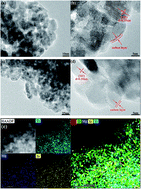Co-Modification of commercial TiO2 anode by combining a solid electrolyte with pitch-derived carbon to boost cyclability and rate capabilities†
Abstract
The bad electrochemical performance circumscribes the application of commercial TiO2 (c-TiO2) anodes in Li-ion batteries. Carbon coating could ameliorate the electronic conductivity of TiO2, but the ionic conductivity is still inferior. Herein, a co-modification method was proposed by combining the solid electrolyte of lithium magnesium silicate (LMS) with pitch-derived carbon to concurrently meliorate the electronic and ionic conductivities of c-TiO2. The homogeneous mixtures were heated at 750 °C, and the co-modified product with suitable amounts of LMS and carbon demonstrates cycling capacities of 256.8, 220.4, 195.9, 176.4, and 152.0 mA h g−1 with multiplying current density from 100 to 1600 mA g−1. Even after 1000 cycles at 500 mA g−1, the maintained reversible capacity was 244.8 mA h g−1. The superior rate performance and cyclability correlate closely with the uniform thin N-doped carbon layers on the surface of c-TiO2 particles to favor the electrical conduction, and with the ion channels in LMS as well as the cation exchangeability of LMS to facilitate the Li+ transfer between the electrolyte, carbon layers, and TiO2 particles. The marginal amount of fluoride in LMS also contributes to the excellent cycling stability of the co-modified c-TiO2.



 Please wait while we load your content...
Please wait while we load your content...